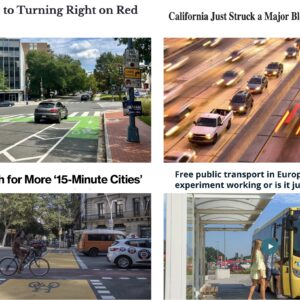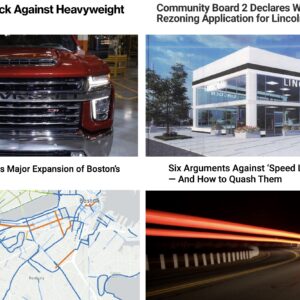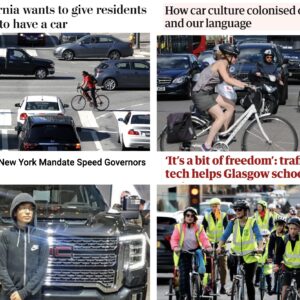
Welcome to the week.
Here are the most notable stories our writers and readers came across in the past seven days…
Good government: It’s a sign of functional governance when leaders have the ability to force corporations to provide healthy messages alongside unhealthy ones. (EuroNews)
Killing freeways: Recent examples from Denver and Los Angeles show that some cities agencies are willing to scrap freeway expansion plans in the name of smart planning and/or public health concerns. (Governing)
Kabul commuting: Biking is booming in Afghanistan since the Taliban takeover, but women riders are nowhere to be found. (NPR)
Critical Mass is back! Feeling extremely inspired to see that hundreds of people turned out to mark the 30th anniversary of Critical Mass in San Francisco. Sometimes I feel like Portland could use more rides like this these days. (SFist)
Transportation leadership: I’m still not tired of reading about Boston and what it must be like to live in a city where the most powerful elected official is actually engaged and knowledgeable about the issue of transportation. (Boston.com)
Off-road artists: Don’t miss this fantastic profile of Brandon Semenuk, who many consider the greatest MTB rider of all time. (Red Bull)
Make drivers pay more: While Portland’s plan to increase driving fees sits on a shelf, there’s a serious debate about congestion pricing happening in New York City. (AMNY)
Hope for Beaverton: Carmel, Indiana offers an inspiring example of how a suburb can grow and densify without expanding roads. (The Economist)
Tragic commentary: The killing of an eight-year-old bike rider on a quiet neighborhood street has sparked an important conversation about how police blame victims and how city officials design streets. (Slate)
Thanks to everyone who sent in links this week!






Thanks for reading.
BikePortland has served this community with independent community journalism since 2005. We rely on subscriptions from readers like you to survive. Your financial support is vital in keeping this valuable resource alive and well.
Please subscribe today to strengthen and expand our work.
The only “hope” for Beaverton is that it doesn’t turn into Portland.
Hope Portland never turns into Beaverton.
Not that Carmel doesn’t have some interesting things going for it, but Beaverton is already much denser than it is. I have high hopes that Kevin Teater will help Beaverton get it right on the areas around the MAX stations.
When you look on Google Maps and streetview, you quickly realize these stories are more hype than real – lots of sidepaths but no actual protected bike lanes; lots of sprawl and rich gated communities but little connectivity. To get anywhere, you take the freeway (by car) to the stroad, then the suburban expressway, past the roundabout to the next expressway, then the connector, then a collector, and finally your local cul-de-sac. Too many roads and too few houses. There is an interurban bikeway that connects to various off-street paths, but it’s hardly progressive when you have to share stroads with fast cars or ride on pathway sidewalks where you can still get hit at unprotected intersections. Still lousy planning.
Shall we even discuss the fact that no bike lane has a trigger for the lights in Beaverton/WashCo.
The one I go through just shopping is crossing Canyon on 117th/Broadway. If you shop early (like I do) you have no choice but to hop on the sidewalk to hit the walk button.
But even that no longer works NB because they’ve closed the crosswalk due to work on the NE corner – so if there isn’t someone crossing N or S in a car or someone hitting the button on the far (West) side – I’m pretty much stuck right now. This is true on many places I ride out there in WashCo.
Getting out in the lane works well on my trike (the metal is low) but not my town bike.
We won’t even discuss the fact that only about 1 in 5 people stop for people in the crosswalk by the MAX tracks on 117th – not even the Beaverton Police.
Shh, don’t let out the secret about Beaverton. Keep its status as the best place to live in the metro area under the rug 😉
I totally hear that! As a Portland resident, I am often jealous of what Beaverton is doing.
And I hope folks know that my inclusion of Beaverton in this is not a slight. It’s because I see them as actually having the capacity to get to the next level.
I certainly didn’t take it as a slight at all! I do see other commenters who have clearly never spent time west of downtown make ill-informed judgments about Beaverton all the time, but never from you or other BP writers.
I’d say that Beaverton really has the best network of multi-use paths in the entire metro area, with the Fanno Creek, Westside, Waterhouse, 26, and other trails being incredible assets. And they’re continuing to expand and connect this trail network to this day.
Just wait until Beaverton politics shifts enough so that they see their wide roads as the perfect places for BRT and cycle lanes and it’ll be the dawn of a new era.
Totally. Beaverton certainly isn’t perfect for transportation by any means — Canyon/TV Highway and Farmington need better N/S crossings, Millikan west of Murray needs a road diet, Walker needs bike lanes and sidewalks, and more. But for the most part, if you find yourself on an unfriendly road, there’s a much friendlier alternative just a few blocks away. And all of their new construction is at least adequate, mostly significantly better than that.
The HWY 26 path from Knollcrest up to Porter then the northside up to Sylvan is fantastic.
To get there from 117th & Center, however requires knowing back roads pretty well and a fairly short, but over 10% climb up past the school to avoid climbing a road with no bike lane where cars travel significantly faster than the posted 25mph.
Riding from 117th & Center to New seasons requires being strong & fearless to take the lane at the end of Center and on Hall and through the parking lot (unless you want to ride narrow sidewalks – I don’t do that, I think it’s rude to peds).
Riding from 117th & Center to access the Fanno Creek trail (East Bound) requires taking the lane on Broadway & Lombard until you’re across Bvtn Hillsdale.
Heading out to Banks requires a short shift in the lane on Cedar hills and then a long run on Jenkins/Baseline before reaching quieter areas.
Finally, most MUPS are far from ideal for commuting – the combination of lots of pedestrians and short sightlines make them terrible for getting anywhere at even a modest clip.
The Economist article is a perfect example of Carmel’s carefully curated image. I saw their mayor speak at a conference in the mid-2010s. The story they tell is that mixed-use and smart growth make good fiscal sense for cities, and just happen to be good urban design too. It gets spun with a folksy ‘gosh, we’ve figured this out, why isn’t everyone else doing it, adopt a bold vision and implement the plan’ message.
They gloss over the fact that their successes rely on extensive government involvement in the private development. The secret sauce is urban renewal (https://www.choosecarmelin.com/redevelopment-projects/projects). They buy up areas of land (‘land assembly’ is the benign moniker; backed by the power of eminent domain) and then sell it to or partner with private development corporations to build out the mixed-use utopia. See 2005 Supreme Court decision in Kelo v. New London.
Carmel gets the tax increment financing windfall to build their infrastructure and fund services, the developers get a consistent supply of development projects with costs defrayed by public money, and the residents get a lot of shiny new buildings. We can only hope that there is a commitment to affordable housing supply buried somewhere in all those stories about skyrocketing property values.
As esteemed commenter David Hamsten notes, the new urban success is limited to a pretty small percentage of the city’s land. They do have a laudable commitment to mixed-use development and smarter growth, at least in the central area of the city. In the context of American suburbia, Carmel is certainly doing it better than most, but there is a lot to unpack about how they got there.
If Portland renews the critical mass events I hope that it does so without the staged confrontations that anger and frighten motorists. More than that I hope the masses do not indulge or tolerate the black bandana anarchists who take every gathering as an invitation to damage property. Portland needs healing not anger generating or destructive mobs. (No I have not joined a CM ride, but when riding I have been, for a while, in one)
What are motorists frightened of, exactly?
“What are motorists frightened of, exactly?”
“Black bandana anarchists who take every gathering as an invitation to damage property.”
As someone with a fair bit of experience riding with Critical Mass, I never saw a car damaged without provocation, but I did see a lot of provocation from motorists, cyclists, and the police alike. I mean, that’s kind of the point isn’t it?
People fear what they don’t understand and hundreds of (traffic) law breaking people could be misunderstood to be a mob
Granpa,
The thing about protest movements is that no one gets to decide how they happen or why they happen. They just happen.
OK I was watching a program set in PDX (So Help Me Todd on CBS) and I was looking forward to seeing cyclists in the background of at least some street scenes, but nary a single 1, 2, or 3 wheeler in any scene, not even someone parking a bike in an office. (Frowny emoji with red face and steam coming out ears)